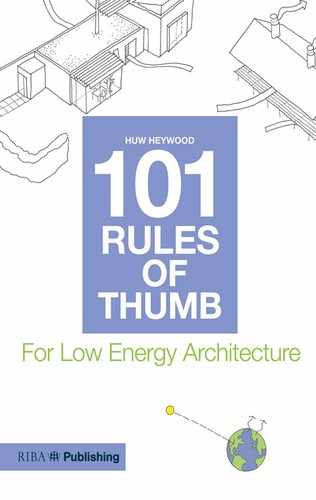Rule 1. Buildings Use Half the World’s Energy
We use half of all the energy we generate in the world, much of which is created by the burning of fossil fuels, to run our buildings. Add transport to and from those buildings, and designers of the built environment have some control over, and responsibility for, 75% of global energy use.
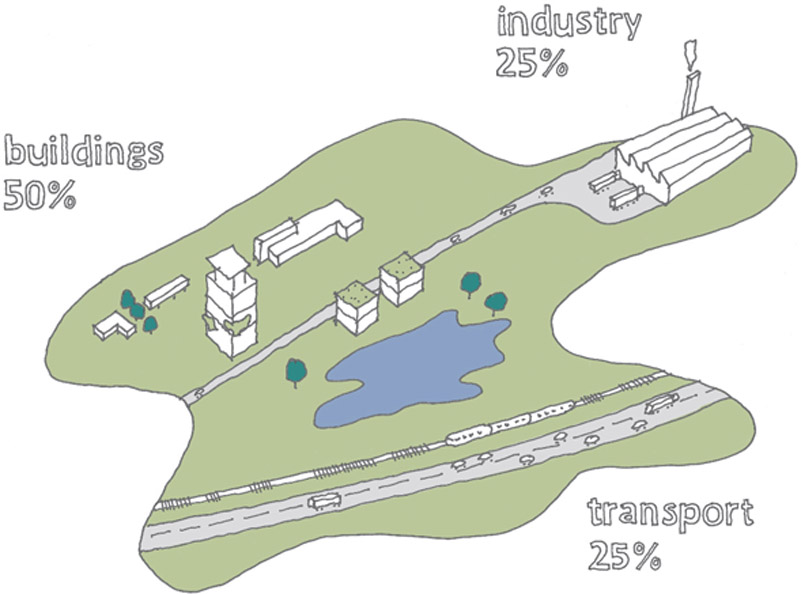
Rule 2. Think before You Build
Buildings last an age and consume energy throughout their lives, so whether to build or not to build is a big question. The answer might be to refurbish, reorganise, change business strategy or change your life rather than to build something new, and this might be the lowest long-term energy-use solution. Consider all options.

Rule 3. The Sun Rises in the East and Sets in the West
It is worth reminding ourselves of this most basic rule. However, it is also worth remembering that, even outside the equatorial regions, in the mid-latitudes of the northern hemisphere winter the sun rises south of east and in the summer it rises north of east. This means that in summer the north face of a building in these regions might be very briefly exposed to the sun, but in the winter the sun will never warm that building’s northern face. In the northern hemisphere, after rising, the sun will be seen traversing across the sky in the south. The reverse is true south of the equator.

Rule 4. The Height of the Sun above the Horizon Determines Many Aspects of a Climate-Responsive Architecture
In December the highest altitude of the sun above the horizon at midday in London is around 15°. This angle varies according to latitude, and that is part of what makes every individual location on earth unique. The diagram gives December sun angles for cities around the world. Using sun-path diagrams or simple-to-use web-based calculators, the position of the sun at any time of day or any time of the year can be found out. Knowing the relative position of earth and sun, or solar geometry, is an important aspect of climate-responsive architecture.

Rule 5. The Sun’s Rays Turn to Heat on Contact with Any Surface
The way this happens is rooted in quantum mechanics, but the simple result is that the earth, and everything on it, is warmed by the sun, making all life possible. The heating of the earth also results in climate and weather, which vary greatly depending upon where we are on the planet.

Rule 6. If You do Not Want Heat inside, Keep the Sun out
Just as the earth is warmed by the sun, so is any other surface that the sun’s rays reach. This is an important rule because if you are trying to avoid overheating in a building you must prevent direct sunlight from entering: once direct sunlight has entered a building, it’s too late to stop it becoming heat.
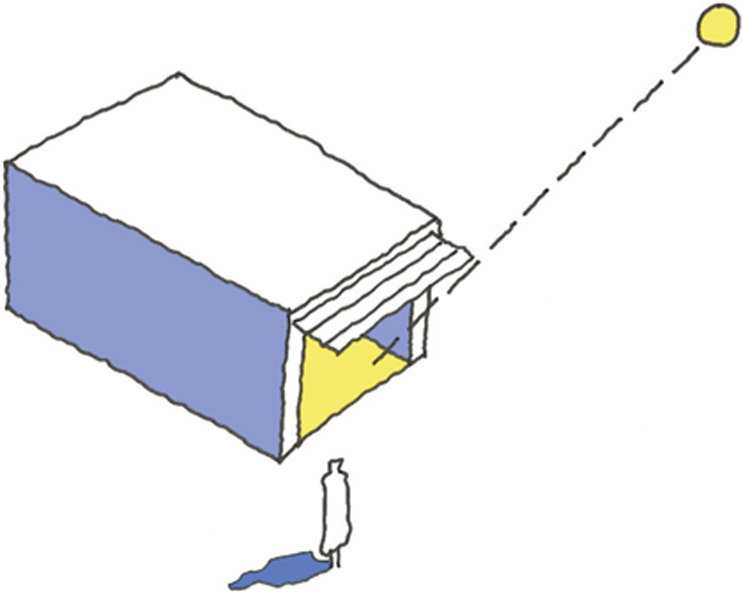
Rule 7. Harness the Power of the Low Winter Sun – it is a Free Source of Heat
In the winter the sun is low in the sky, so the sun can penetrate deep into a space, if it is allowed to, bringing free heat with it.

Rule 8. Prevent Overheating in Summer
In the summer the sun is high in the sky, reaching, in June, a maximum angle of about 62° above the horizon in London, 73° in both Beijing and New York, and 83° in Cairo. In Sydney in December the sun reaches about 80° above the horizon. For solar-oriented windows a simple, external horizontal shading device can prevent this high-angle summer sun from entering a building. Rule-of-thumb depths of projection from near the head of a window are: 600–900mm deep in the mid-latitudes; and at least 1,200mm deep close to the equator, where a combination of vertical and horizontal projections should be employed.

Rule 9. Site Topography Informs Us about Building Location
Topography, the form of the land, must be studied before you begin to design. Wind direction and intensity are affected by hills, valleys and other natural features. Often, in valleys and mountainous terrain the wind patterns change between day and night. The direction of the wind might be read in the direction in which grasses have been blown on a site.

Rule 10. A Windbreak will Halve the Wind Speed and Lead to Reduced Cooling of the Building Envelope
A windbreak, or shelter belt, will significantly influence the wind. Locating a building on the leeward side of a well-designed windbreak can result in energy savings of 15 to 20% because cooling of the building envelope is reduced. Position the building within five times the height of the windbreak. Remember: you will want to permit, not block, the passage of breezes in tropical regions.

Rule 11. The Wind Speed will be Influenced at a Great Distance from a Windbreak
The wind’s velocity will be reduced up to around 20 times the height of the windbreak, so even distant shelter belts will contribute to reduced energy use.
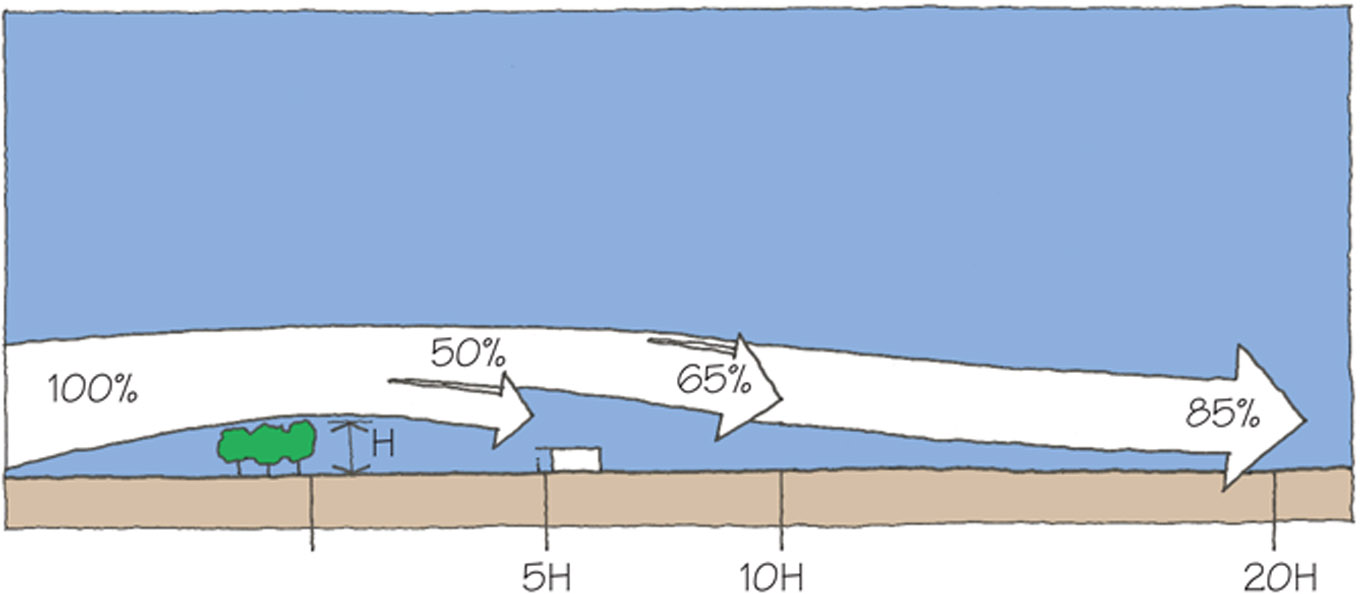
Rule 12. The Presence of Water is a Free Source of Cooling
A body of water, such as a lake or the sea, will influence air temperature and humidity. Water that has been exposed to the night sky in summer will cool the breeze that passes over it during warm days. Site a building such that water-cooled breezes can be directed into it. Daytime onshore sea breezes should be put to use by orienting buildings towards the sea in humid and warm climates and seasons.

Rule 13. Avoid Overshadowing in Winter, as this will Cool the Building Envelope
The envelope of a building must be kept warm in cooler climates and seasons. If it is in shade, more energy will be needed to achieve comfortable thermal conditions within.
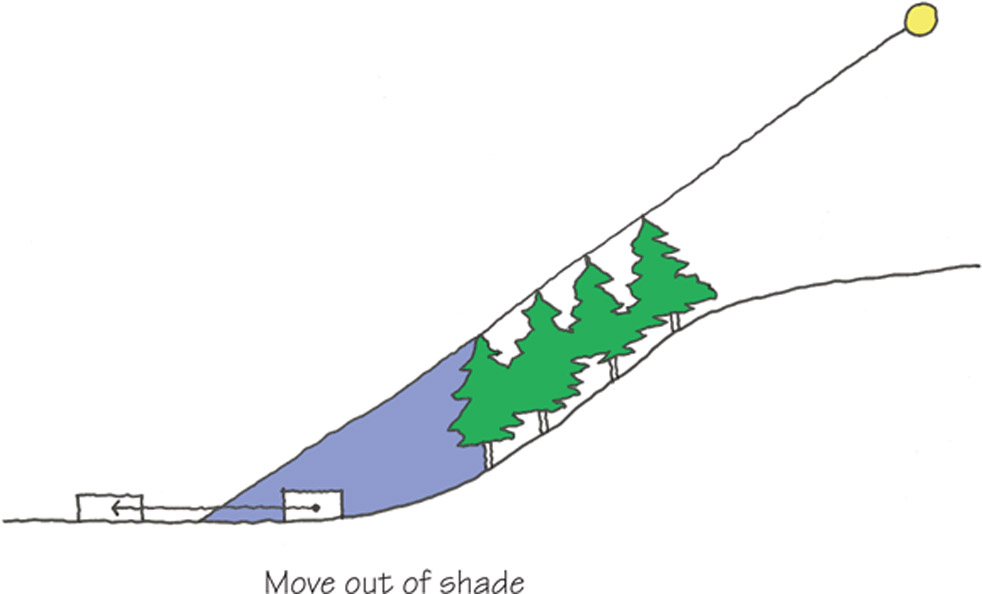
Rule 14. Trees can Provide Summer Shading and Allow Winter Solar Gains
Trees can be useful shading devices. Deciduous trees can block up to 85% of the sun’s radiation in summer. In winter, without leaves, they permit up to 70% of the sun’s energy to pass between their bare branches. However, it would take a very large tree to almost fully shade a solar-oriented façade in summer, and proximity to trees and tree roots might bring other problems for both building and tree. A compromise rule of thumb is to position the tree such that the canopy sits outside a line drawn at 45° from the base of the building, as indicated in the lower diagram.

Rule 15. Use Landscape for Free Summer Cooling
Planting can be used not only to divert the path of the wind but also to assist in the cooling of breezes. The ground shaded by a tree or other planting will be cooler than the surrounding areas, and so warm breezes will be cooled as they pass over the shaded ground. The rule is applicable in both urban and rural situations.

Rule 16. Provide Shelter from Wind and Rain
Wind and rain reduce the temperature of the building envelope, leading to the need for additional energy to heat the interior in cool climates and seasons. Roof overhangs can provide protection from rain. Windbreaks can take a number of forms, all of which can become architectural devices in a design:
- Trees
- Hedges
- Fences
- Garden walls
- Courtyards
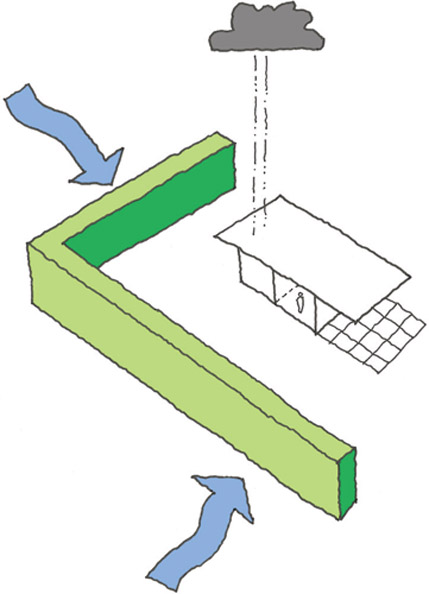
Rule 17. Built Form can be Used for Wind Protection
Surrounding buildings and walls can be effectively employed as windbreaks. Unlike many large modern cities, medieval town plans and those of mountain villages that are subject to extreme winds do not have a regular grid of streets through which wind has unobstructed access. The direct passage of the wind is impeded by using built form as a barrier.
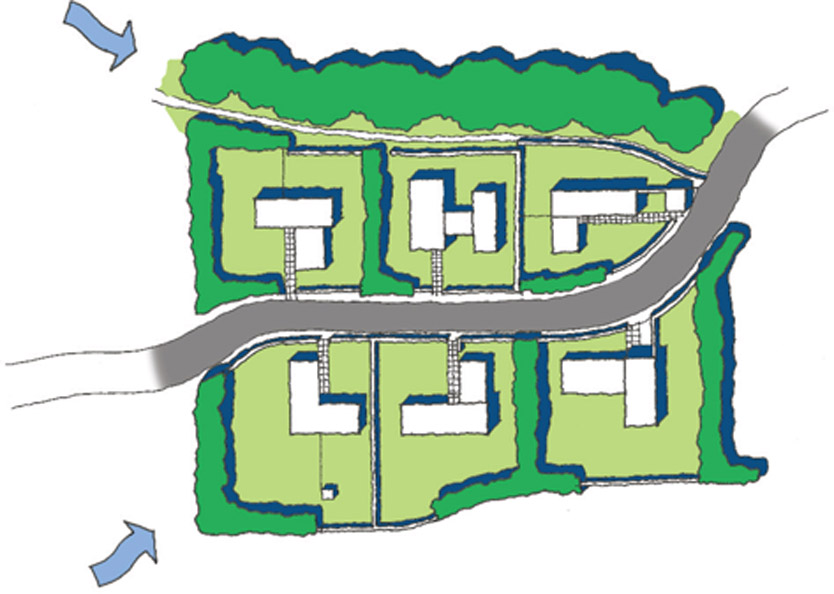
Rule 18. A Western Tree Belt can Provide Shade from the Late Afternoon Sun
A carefully positioned tree belt on the western boundaries of a building can give protection from the significant heat of the late-afternoon summer sun. Care needs to be taken to ensure that the winter sun’s beneficial heat is not also blocked if working in temperate and cold climate zones. An eastern tree belt will also be beneficial in hot climates, where the morning sun is a powerful force.

Rule 19. ‘Climate is What You Expect, Weather is What You Get’
Sci-fi author Robert Heinlein brought us this useful rule. The weather in Paris might be unseasonably cold with snow storms approaching, but the climate is temperate. Weather, which exists in the thin weather layer surrounding the earth, is a measure of the atmosphere at a particular time. Climate relates to the condition of the atmosphere over a long period of time. Both must be studied in order to know the conditions a building needs to respond to.

